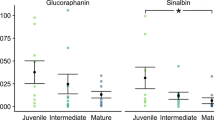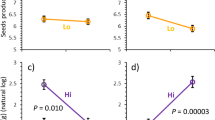Abstract
Floral herbivory represents a major threat to plant reproductive success, driving the importance of plant tolerance mechanisms that minimize fitness costs. However, the cumulative insect herbivory plants experience under natural conditions complicates predictions about tolerance contributions to net fitness. Apical damage can lead to compensatory seed production from late season flowering that ameliorates early season fitness losses. Yet, the compensation realized depends on successful development and herbivore escape by later season flowers. Using monocarpic perennial Cirsium canescens, we quantified seed-reproductive fitness of plants with vs. without experimental damage to the early-developing large apical flower head, with and without a 30–40% herbivory reduction on subsequent flower heads, for two flowering cohorts. Plants with reduced herbivory clearly demonstrated the release of apical dominance and compensation, not overcompensation, for apical damage via greater seed maturation by later flower heads. In contrast, plants that experienced ambient herbivory levels on subsequent heads undercompensated for early apical damage. Individuals had lower total seed set when the apical head was damaged. Compensation was, therefore, possible through a small increase in total flower heads, caused by a higher rate of floral bud survival, and a higher seed maturation rate by subsequent heads, leading to more viable seeds per matured flower head. With ambient cumulative floral herbivory, compensation for apical damage was not sufficient to improve fitness. Variation in the intensity of biological interactions played a role in the success of plant tolerance as a mechanism to maximize individual fitness.




Similar content being viewed by others
References
Aarssen LW (1995) Hypotheses for the evolution of apical dominance in plants: implications for the interpretation of overcompensation. Oikos 74:49–156
Adhikari S, Russell FL (2014) Effects of apical meristem mining on plant fitness, architecture, and flowering phenology in Cirsium altissimum (Asteraceae). Am J Bot 101:2079–2087
Agrawal AA (2000) Overcompensation of plants in response to herbivory and the by-product benefits of mutualism. Trends Plant Sci 5(7):309–313
Agrawal AA (2005) Future directions in the study of induced plant responses to herbivory. Entomol Exp Appl 115:97–105
Agrawal AA, Hastings AP, Johnson MTJ, Maron JL, Salminen J-P (2012) Insect herbivores drive real-time ecological and evolutionary change in plant populations. Science 338:113–116
Aikens ML, Roach DA (2015) Potential impacts of tolerance to herbivory on population dynamics of a monocarpic herb. Am J Bot 102(11):1901–1911
Banta JA, Stevens MHH, Pigliucci M (2010) A comprehensive test of the ‘limiting resources’ framework applied to plant tolerance to apical meristem damage. Oikos 119:359–369
Brody AK, Irwin RE (2012) When resources don’t rescue: flowering phenology and species interactions affect compensation to herbivory in Ipomopsis aggregate. Oikos 121:1424–1434
Brody AK, Price MV, Waser NM (2007) Life history consequences of vegetative damage in scarlet gila, a monocarpic plant. Oikos 116(6):975–985
Carmona D, Fornoni J (2013) Herbivores can select for mixed defensive strategies in plants. New Phytol 197:576–585
Childs DZ, Metcalf CJE, Rees M (2010) Evolutionary bet-hedging in the real world: empirical evidence and challenges revealed by plants. Proc Royal Soc B 277:3055–3064
Ehrlén J (1996) Spatiotemporal variation in predispersal seed predation intensity. Oecologia 108:708–713
English-Loeb GM, Karban R (1992) Consequences of variation in flowering phenology for seed head herbivory and reproductive succes in Erigeron glaucus (Compositae). Oecologia 89:588–595
Fornoni J (2011) Ecological and evolutionary implications of plant tolerance to herbivory. Funct Ecol 25:399–407
Gonzáles WL, Suárez LH, Molina-Montenegro MA, Gianoli E (2008) Water availability limits tolerance of apical damage in the Chilean tarweed Madia sativa. Acta Oecologia 34:104–110
Gruntman M, Novoplansky A (2011) Ontogenetic contingency of tolerance mechanisms in response to apical damage. Ann Bot 108:965–973
Huhta A, Lennartsson T, Tuomi J, Rautio P, Laine K (2000) Tolerance of Gentianella campestris in relation to damage intensity: an interplay between apical dominance and herbivory. Evol Ecol 14:373–392
Janovský Z, Janovská M, Weiser M, Horčičková E, Ŕíhová D, Münzbergová Z (2016) Surrounding vegetation mediates frequency of plant–herbivore interactions in leaf-feeders but not in other herbivore groups. Basic Appl Ecol 17:352–359
Järemo J, Palmqvist E (2001) Plant compensatory growth: a conquering strategy in plant-herbivore interactions? Evol Ecol 15:91–102
Jongejans E, Shea K, Skarpaas O, Kelly D, Shepphard A, Woodburn T (2008) Dispersal and demography contributions to population spread of Carduus nutans in its native and invaded ranges. J Ecol 96:687–697
Juenger T, Bergelson J (2000) The evolution of compensation to herbivory in scarlet gilia, Ipomopsis aggregata: herbivore-imposed natural selection and the quantitative genetics of tolerance. Evolution 54:764–777
Kafle D, Hanel A, Lortzing T, Steppuhn A, Wurst S (2017) Sequential above- and belowground herbivory modifies plant responses depending on herbivore identity. BMC Ecol 17:5
Kaul RB, Sutherland DM, Rolfsmeier SB (2007) The Flora of Nebraska. University of Nebraska-Lincoln, Lincoln
Keeler KH, Harrison AT, Vescio LS (1980) The flora and Sandhills prairie community of Arapaho Prairie. Prairie Nat 12:65–78
Klimešová J, Sosnová M, Martínková J (2007) Life-history variation in the short-lived herb Rorippa palustris: effect of germination date and injury timing. Plant Ecol 189:237–246
Klimešová JM, Malíková L, Rosenthal J, Šmilauer P (2014) Potential bud bank responses to apical meristem damage and environmental variables: matching or complementing axillary meristems? PLoS ONE 9:e88093. https://doi.org/10.1371/journal.pone.0088093
Kolb A, Leimu R, Ehrlén J (2007) Environmental context influences the outcome of a plant–seed predator interaction. Oikos 116:864–872
Krimmel B, Pearse IS (2016) Tolerance and phenological avoidance of herbivory in tarweed species. Ecology 97(5):1357–1363
Lamp WO (1980) Pre-dispersal seed predation of the Platte thistle and its effects on seed production. PhD Dissertation. University of Nebraska-Lincoln, Lincoln
Lamp WO, McCarty MK (1981) Biology and ecology of the Platte thistle (Cirsium canescens). Weed Sci 29:686–692
Lamp WO, McCarty MK (1982) Predispersal seed predation of a native thistle, Cirsium canescens. Environ Ent 11(4):847–851
Lay CR, Linhart YB, Diggle PK (2011) The good, the bad and the flexible: plant interactions with pollinators and herbivores over space and time are moderated by plant compensatory responses. Ann Bot 108:749–763
Lehndal L, Ågren J (2015) Latitudinal variation in resistance and tolerance to herbivory in the perennial herb Lythrum salicaria is related to intensity of herbivory and plant phenology. J Evol Biol 28:576–589
Lehndal L, Hambäck PA, Ericson L, Ågren J (2016) Herbivory strongly influences among-population variation in reproductive output of Lythrum salicaria in its native range. Oecologia 180:1159–1171
Lehtilä K (2000) Modelling compensatory regrowth with bud dormancy and gradual activation of buds. Evol Ecol 14:315–330
Lennartsson T, Nilsson P, Tuomi J (1998) Induction of overcompensation in the field gentian Gentianella campestris. Ecology 79(3):1061–1072
Louda SM (1982) Distribution ecology: variation in plant recruitment in relation to insect seed predation. Ecol Monog 52:25–41
Louda SM (1983) Seed predation and seedling mortality in the recruitment of a shrub, Haplopappus venetus (Asteraceae), along a climatic gradient. Ecology 64:511–521
Louda SM (1998) Population growth of Rhinocyllus conicus (Coleoptera: Curculionidae) on two species of native thistles in prairie. Env Entomol 27:834–841
Louda SM, Potvin MA (1995) Effect of inflorescence-feeding insects on the demography and lifetime fitness of a native plant. Ecology 76:229–245
Louda SM, Potvin MA, Collinge SK (1990) Predispersal seed predation, postdispersal seed predation and competition in the recruitment of seedlings of a native thistle in Sandhills prairie. Am Midl Nat 124:105–113
Louda SM, Kendall D, Connor J, Simberloff D (1997) Ecological effects of an insect introduced for the biological control of weeds. Science 277:1088–1090
Low C, Ellner SP, Holden MH (2013) Optimal control and cold war dynamics between plant and herbivore. Am Nat 182(2):E25–E29
Lowenberg GJ (1994) Effects of floral herbivory on maternal reproduction in Sanicula arctopoides (Apiaceae). Ecology 75(2):359–369
Lucas-Barbosa D (2016) Integrating studies on plant–pollinator and plant–herbivore interactions. Trends Plant Sci 21(2):125–133
McCall AC, Irwin RE (2006) Florivory: the intersection of pollination and herbivory. Ecol Lett 9:1351–1365
Nguyen D, Rieu I, Mariani C, van Dam NM (2016) How plants handle multiple stresses: hormonal interactions underlying responses to abiotic stress and insect herbivory. Plant Mol Biol 91:727–740
Nilsson P, Tuomi J, Åström M (1996) Bud dormancy as a bet-hedging strategy. Am Nat 147:269–281
Paige KN (1992) Overcompensation in response to mammalian herbivory: from mutualistic to antagonistic interactions. Ecology 73:2076–2085
Pilson D, Decker KL (2002) Compensation for herbivory in wild sunflower: response to simulated damage by the head-clipping weevil. Ecology 83:3097–3107
R Core Team (2016) R: a language and environmental for statistical computing. R Foundation for Statistical Computing, Vienna. http://www.R-project.org
Rand TA, Louda SM (2012) Exotic weevil invasion increases floral herbivore community density, function, and impact on a native plant. Oikos 121:85–94
Rose KE, Louda SM, Rees M (2005) Demographic and evolutionary impacts of native and invasive insect herbivores on Cirsium canescens. Ecology 86:453–465
Russell FL, Louda SM (2005) Indirect interaction between two native thistles mediated by an invasive exotic floral herbivore. Oecologia 146:373–384
Starrfelt J, Kokko H (2012) Bet-hedging—a triple trade-off between means, variances and correlations. Biol Rev 87:742–755
Stieha CR, Abbott KC, Poveda K (2016) The effects of plant compensatory regrowth and induced resistance on herbivore population dynamics. Am Nat 187(2):167–181
Stowe KA, Marquis RJ, Hochwender CG, Simms EL (2000) The evolutionary ecology of tolerance to consumer damage. Ann Rev Ecol Syst 31:565–595
Strauss SY, Agrawal AA (1999) The ecology and evolution of plant tolerance to herbivory. Trends in Ecol Evol 14:179–185
Tenhumberg B, Louda SM, Eckberg JO, Takahashi M (2008) Monte-Carlo analysis of parameter uncertainty in matrix models of the weed Cirsium vulgare. J Appl Ecol 45:438–447
Underwood N, Halpern SL (2012) Insect herbivores, density dependence, and the performance of the perennial herb Solanum carolinense. Ecology 93(5):1026–1035
Vail SP (1992) Selection for overcompensatory plant responses to herbivory: a mechanism for the evolution of plant-herbivore mutualism. Am Nat 139:1–8
Von Euler T, Ågren J, Ehrlén J (2014) Environmental context influences both the intensity of seed predation and plant demographic sensitivity to attack. Ecology 95(2):295–504
Wise MJ, Abrahamson WG (2007) Effects of resource availability on tolerance of herbivory: a review and assessment of three opposing models. Am Nat 169:443–454
Wise MJ, Cummins JJ, De Young C (2008) Compensation for floral herbivory in Solanum carolinense: identifying mechanisms of tolerance. Evol Ecol 22:19–37
Author information
Authors and Affiliations
Contributions
NW and SL conceived and designed the experiments. NW performed the experiments and analyzed the data. NW and SL wrote the manuscript.
Corresponding author
Additional information
Communicated by Caroline Müller.
Electronic supplementary material
Below is the link to the electronic supplementary material.
Rights and permissions
About this article
Cite this article
West, N.M., Louda, S.M. Cumulative herbivory outpaces compensation for early floral damage on a monocarpic perennial thistle. Oecologia 186, 495–506 (2018). https://doi.org/10.1007/s00442-017-4027-9
Received:
Accepted:
Published:
Issue Date:
DOI: https://doi.org/10.1007/s00442-017-4027-9




